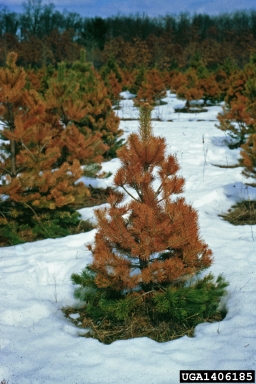
Although it’s not yet winter, it’s time to prepare your trees for the cold weather and drying winds that are coming. Winter burn is an unsightly and possibly deadly condition that affects all evergreens. It causes your evergreen needles/leaves to die and turn brown and can have a big health impact on the tree. Read on to learn how to spot the signs of winter burn and how to prevent winter burn damage on your evergreens.
What Causes Winter Burn?
This unsightly browning of Evergreens stems from the fact that trees and shrubs lose moisture through their pores which are located on their leaves/needles. During the winter months, the dry air and wind accelerate this effect leading to leaves increasing their water demand from the roots in order to survive. However, the root system usually has a hard time keeping up with the leaves’ demand. This is usually because the roots weren’t able to store enough water before winter and now can’t absorb it from the frozen ground. The result: leaves and needles turning brown and dying. This cycle is called desiccation.
Trees Susceptible To Winter Burn:
Boxwood, holly, rhododendron, fir, hemlock, pine, spruce, yew, arborvitae, false cypress, juniper commonly suffer from winter burn.
Sometimes the placement of a tree/shrub makes it more vulnerable to winter burn as well. For example, trees that act as windbreaks, are in open unprotected areas, or in sunny areas are more susceptible. The age of the tree matters as well. Younger trees with less established root systems are more susceptible than older, well-established trees.
Signs & Symptoms Of Winter Burn

The biggest telltale sign of winter burn is the browning/yellowing of the tree’s needles. Symptoms are often delayed and don’t show up until late winter/early spring. However, by then the damage is already done which is why it’s important to begin treatments in late fall.
Symptoms include:
- Yellowing/Browning of Needles/Leaves
- Browning starting at tips of needles and edges of leaves moving into the center of the tree as it gets more severe.
- Needles/leaves falling off of Evergreens
Need Help With Winter Burn?
Or Call 703-573-3029
Treatment For Winter Burn:
Anti-desiccants are the best way to stop winter burn. Anti-Desiccants coat the upper and lower foliage in a protective wax coating reducing the moisture lost through the leaves. Similar to the moisturizers, lotions, and humidifiers we use to keep our skin hydrated in the winter, anti-desiccants provide trees & shrubs with the protection they need to flourish during winter instead of fighting to survive. On an aesthetic note, this means no more brown and dying evergreens!
Note: Anti-Desiccants should not be used on waxy-blue conifers such as blue spruce. Anti-desiccants will remove the blue tint of these trees.

Benefits Of Anti-Desiccants:
Anti-Desiccants are mainly used to protect evergreens from winter burn; however, they also provide a number of other benefits that improve the health and appearance of your tree.
Benefits include:
- Protection from winter burn: Leaves turning brown and dying.
- Prevents drought stress
- Protection from leaf scorch
- Helps trees suffering from root system issues
- Makes trees look brighter and shinier/Adds a polished look to your landscape.
- Protects from de-icing salt damage
- It’s Eco-Friendly (100% Organic & Biodegradable)
Other ways to reduce damage from winter burn
Mulching: Mulching insulates a tree’s roots and helps the soil retain moisture during extreme temperatures. Winter burn is caused by the loss of water through a tree’s leaves/needles, having water reserves in the soil can help replace the water that was lost. By helping the soil retain moisture, mulching helps reduce the effects of winter burn.
Watering: Make sure your tree is properly watered this fall. Proper watering can help the tree store water in its roots. The more water the tree stores the less damage it will occur from winter burn. Once winter comes along you can still water your tree to help reduce the damage from winter burn. We suggest following our winter watering tips to make sure you’re watering properly.
Wrapping Trees: One way to give your tree/shrubs extra protection from winter burn is to wrap them. This adds a physical barrier to stop the wind before it hits the tree’s leaves/needles. We suggest purchasing burlap tree wrap and following simple application tutorials online to protect your trees in winter.
If you want to protect your trees from winter burn this year. We can help. Give us a call at 703-573-3029 or book an appointment online to learn more about Anti-Desiccants and get your trees protected this year.


